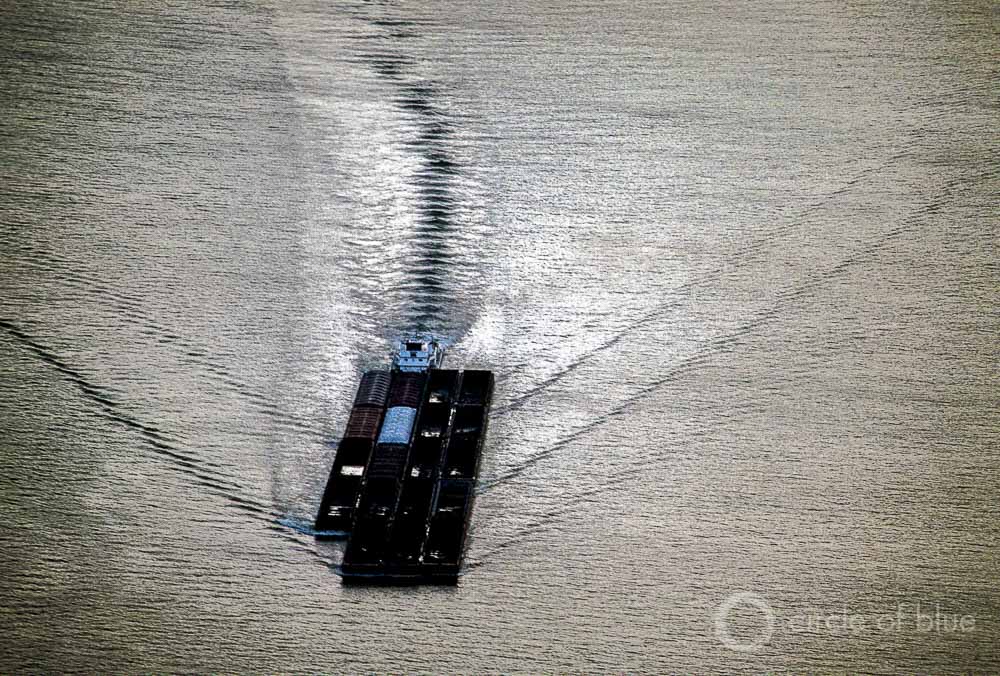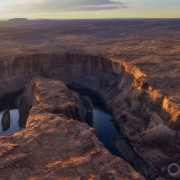Opinion: Halt the Oil Flow Across Straits of Mackinac
Civic opposition and litigation aims to end Line 5 operation.

Photo © J.Carl Ganter/ Circle of Blue
Keith Schneider, senior editor and chief correspondent at Circle of Blue, launches a new column offering insights and commentary on water-related trends and news. This marks the debut of his bimonthly publication.
By Keith Schneider, Circle of Blue – January 22, 2025
From the perspective of Americans who live in Michigan and Wisconsin, the Line 5 oil pipeline across the Straits of Mackinac makes no sense.
It’s old, 72 years old. Line 5 is older than the U.S. interstate highway system, and that’s been in major repair for a quarter century.
It’s in the wrong place. The pipeline’s 645 mile-long corridor from Superior, Wisconsin, to a refinery in Sarnia, Ontario, includes 4.5 miles of bottomlands submerged 130 feet below the surface of the Straits of Mackinac. Dividing Michigan’s Lower and Upper Peninsulas the Straits are an irreplaceable expanse of clean water that connects two of the planet’s largest bodies of fresh water — Lake Michigan and Lake Huron. If Line 5 ruptures, according to a study 11 years ago by the University of Michigan, oil would contaminate the waters and shoreline of both lakes for 50 miles.
And it’s owned by a Canada-based company, Enbridge Inc., that has amassed a truly worrisome record of unsafe operations. One summary of the company’s litany of ruptures and leaks by 350.org, a climate advocacy group, found that from 1996 to 2014 Enbridge pipelines in the U.S. and Canada experienced 1,000 accidents that spilled nearly 9.5 million gallons of oil on land and into water. The worst accident was in Michigan in 2010 when an Enbridge line ruptured and poured 1 million gallons into the Kalamazoo River, the worst inland oil spill in U.S. history.
How Does Line 5 Keep Operating?
Given the potentially catastrophic risk and Enbridge’s anxiety-generating spill record it’s natural to wonder how Line 5 is allowed to keep operating. The answer to that is steadily approaching.
Enbridge faces a June 16, 2026, deadline set by a U.S. District Court judge for halting Line 5 operations where the pipeline crosses 12 miles of tribal land controlled by the Bad River Band of Lake Superior Chippewa. The tribe also is challenging state permits issued by the Wisconsin Department of Natural Resources for Enbridge to construct a 41-mile bypass across protected forest and wetlands.
Meanwhile in Michigan, Attorney General Dana Nessel is nearing a decision in her six-year-old state lawsuit to halt oil from crossing the Straits. Oral arguments in that case are scheduled for January 27, 2025, in state Circuit Court Judge James S. Lamo’s courtroom in Lansing.
Lying at the foundation of these two cases and several others brought by environmental organizations is an impediment that Enbridge’s opponents are determined to overcome: Line 5 is an operating oil pipeline.
Enbridge is spending a fortune arguing in court and in regulatory forums that its operations are protected by easements and legal agreements the company signed with Michigan, and pipeline treaties that Canada reached with the U.S. In other words, Enbridge insists it has the right and authority to operate Line 5, just as it’s done since 1953.
It doesn’t, according to Attorney General Nessel. The federal Pipeline Safety Act and the 1977 Transit Treaty between the U.S. and Canada, the two principal laws overseeing Line 5 operations in the Straits, expressly state Michigan’s authority to protect state waters from Line 5’s risks.
Knowing the considerable strength of its adversaries, Enbridge has not been foolish. The energy sector and pipeline politics of the 21st century are much different than they were decades ago. Oil pipelines are a target of opposition campaigns, many focused on reducing carbon fuels to combat climate change, that have stopped proposed oil pipelines. Protests across the Great Plains states, for instance, prevented construction of the Keystone XL pipeline four years ago.
Shifting market conditions also are a hazard. Diminished demand for oil in the wake of the Covid-19 pandemic shelved the planned 650-mile Red Oak pipeline from Oklahoma to the Texas Gulf Coast.
Enbridge Blinks
Enbridge, which earned over $32 billion in revenue in 2023, is acutely aware that elderly Line 5 at the bottom of the Straits of Mackinac is vulnerable to the active and influential coalition of state officials, tribes, business and community leaders, and environmental organizations determined to shut it down. So seven years ago the company extended a compromise idea. It proposed to build a new tunnel through bedrock below the Straits bottomland to shield the pipeline from any hazard, like the six-ton anchor that dropped from a barge and gouged the pipeline in 2018.
In December 2023 the Michigan Public Service Commission (MPSC) thought well enough of that expensive and problematic project and approved a permit to build the tunnel. The permit, like every other big decision about Line 5 that came before it, introduced another realm of conflict. Five Native American tribes in Michigan, and several environmental organizations appealed the commission’s decision.
But the permit approval also produced an unexpected ally for Enbridge. It caused the state of Michigan to switch sides and support the Enbridge tunnel. Assistant Attorney General Daniel Sonneveldt, the MPSC’s attorney, argued that turning aside the proposed tunnel meant that “the existing seabed pipeline would continue to operate across the Straits of Mackinac. It would continue to run the product through that pipeline and the risk of the spill still remains and exists there.”
There is plenty of room to argue that a tunnel is not a sane alternative to an old and vulnerable bottomland oil pipeline. Engineers are raising questions about the stability of the bedrock. And Enbridge operates an existing pipeline network around Lake Michigan that is capable of transporting oil and natural gas liquids to Sarnia without crossing the Straits.
New Challenge: Tunnel Expense
The cost of the tunnel also looks to be prohibitive. A new report by the Institute for Energy Economics and Financial Analysis, a respected Cleveland-based research group, found that Enbridge’s original $500 million price estimate could soar to $1.5 billion. That’s because the tunnel will need to be constructed much further beneath the bottom of the Straits than Enbridge initially proposed.
If the decade of the 2020s has taught us anything it’s that bad behavior is now defensible and that defiance of reason is regarded by some as virtuous. Let’s be clear. There is no virtue in the 540,000 barrels of oil that Line 5 transports daily across the bottom of the Straits of Mackinac. Each barrel is a contamination threat to two Great Lakes.
In 2012, more than a decade ago, two researchers from the National Wildlife Federation published a remarkable investigative report on the “ever-present” sunken hazard of Line 5. The report launched the cascade of protest and litigation focused on shutting off the oil flowing across the Straits of Mackinac. For the safety of the Great Lakes, and all they mean to the communities both natural and human that depend on them, it’s imperative that the pipeline’s opponents achieve that goal.
Circle of Blue’s senior editor and chief correspondent based in Traverse City, Michigan. He has reported on the contest for energy, food, and water in the era of climate change from six continents. Contact
Keith Schneider












Leave a Reply
Want to join the discussion?Feel free to contribute!